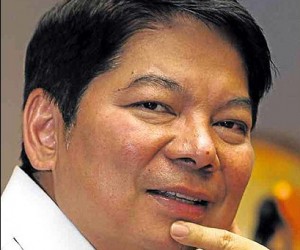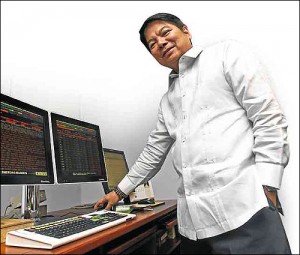He wanted to be a doctor, then lawyer, but never banker

GOVERNOR Amando M. Tetangco Jr., 58, is the first person to be serving as BSP governor for two terms. PHOTO BY RAFFY LERMA
BECOMING a central bank governor was never a dream he had as a child. Like any typical smart kid, Amando M. Tetangco Jr. wanted to become either a medical doctor or a lawyer.
Nevertheless, aided by his skills, fate put him at the helm of the Bangko Sentral ng Pilipinas and led him to becoming recognized globally as a Grade-A central banker.
Tetangco, known to his friends as “Say,” a nickname given to him by neighbors since he was born at the height of popularity of Ramon Magsaysay, is the first person to be serving as BSP governor for two terms. President Aquino has just extended his tenure for another six years, or until July 2017, given his accomplishments in his field.
The President had all the reason to do so; the international community itself has recognized Tetangco for his skills in conducting monetary policy and bank regulation –the two main tasks of the central bank.
In 2007, international business magazine Global Finance gave him a grade of “A” for central banking together with only a few other central bank heads. US Federal Reserve Chair Ben Bernanke, by the way, got only a grade of “C.”
Article continues after this advertisementTetangco spent his grade school and high school in Pampanga, but eventually went to Manila to take economics at the Ateneo de Manila University.
Article continues after this advertisement“In grade school, I wanted to become a doctor. In high school, I wanted to become a lawyer. But I eventually decided to take economics because medicine and law required a lot of years of study,” Tetangco tells SundayBiz, explaining that he wanted to become self-supporting much sooner.

TETANGCO, known to his friends as “Say,” is a nickname given to him by neighbors since he was born at the height of popularity of Ramon Magsaysay. PHOTO BY RAFFY LERMA
Hard work was one of the many values his parents inculcated in him and his eight other siblings, he says.
After graduating from college, which he finished cum laude, Say worked for about a year at financial services firm SGV before applying at the Central Bank of the Philippines (which is the Bangko Sentral ng Pilipinas today).
Unlike most applicants, Say had the guts to send his application letter directly to the office of then Central Bank Governor Gregorio Lecaros.
“I sent my letter directly to Governor Lecaros. I told him I was impressed by the functions and policies of the central bank,” says Tetangco, who eventually got a call from the central bank’s human resource department.
Toughest challenges at the central bank
Tetangco, who started as an employee at the BSP’s statistics department, rose from the ranks.
He was the director of the international economic research department when the Philippines called for a debt moratorium in the early 1980s. The country only had $500 million in foreign exchange reserves back then, and so it did not have money to pay its debts to foreign creditors. The amount was even barely enough to meet the country’s import requirements.
Given his position at the central bank, Tetangco was part of the team that talked to officials from various creditors of the Philippines, including foreign commercial banks, and bilateral as well as multilateral creditors, to help arrive at a debt-restructuring package for the country.
Another tough time was in the late 1990s when the Asian financial crisis struck. At the time, Tetangco was managing director for economic research and treasury. The regional crisis dragged down Asian currencies, including the peso, thus bloating the dollar-denominated debts of countries in the region.
“It was a very challenging time. We had to implement measures to put the foreign exchange market and the financial system back to stability,” Tetangco recalls.
A family man
Besides his skills in central banking, his healthy relation with his family is another thing that characterizes Tetangco. While his weekdays are busy, he finds time on weekends to enjoy the company of his wife and three children.
“We would go to the mall, have lunch or dinner together. Sometimes, we would just lounge on the sofa to watch TV,” he says.
On some cocktail occasions, Tetangco would be spotted with his wife, Elma, a former officemate whom he says with a smile was known at the BSP for her beauty and brains. Elma, he says, understands the significant amount of time he has to spend at work.
“She is supportive of me,” Tetangco says.
Tetangco as a boss
Even with the demands of his job, Tetangco is often seen in public as having a calm disposition. From time to time, he would step out of his office to attend social activities for BSP employees. Sometimes, he would visit the gym at the BSP to exercise together with the employees.
He says he values spending time with BSP employees.
Reforms
Asian countries learned a lot from the crisis in the late 1990s. In the case of the Philippines, the BSP instituted quite a number of reforms both in monetary policy (the function that deals with keeping price increases, or inflation, moderate) and bank regulation.
“Our situation now is very far from that in the 1980s and 1990s,” Tetangco says. For instance, he says, the country has now over $66 billion in foreign exchange reserves.
Tetangco eventually became deputy governor for the monetary sector, a job through which he helped institute skills training at the BSP to enhance econometric modeling and improve capacity to manage inflation.
The BSP pays particular attention to training its human resources to ensure it is able to adopt international best practices, he says. “We put premium on improving the analytic skills of our staff. We would send them to trainings both here and abroad,” he says.
Tetangco himself has an extensive training in his field. In his earlier years at the BSP, he was sent to the University of Wisconsin in the United States to study Master in Public Policy and Administration as a central bank scholar.
Given Tetangco’s dedication to his job, it was impossible for his former boss, the late BSP Governor Rafael Buenaventura, not to notice his qualifications.
Getting appointed
The position of a central bank governor, more often than not, would be awarded to someone outside the central bank who is well known to the incumbent President.
Given his lack of connection to then President Gloria Macapagal-Arroyo, some doubted the chance for Tetangco to be appointed governor of the BSP, a highly coveted post, despite his credentials.
Good thing he has the trust of Buenaventura, who pushed for Tetangco to be his successor. Tetangco acknowledges the confidence in him of the late central bank governor, saying “he is one of my supporters.”
Thus, in July 2005, with the backing of Buenaventura, Tetangco was indeed appointed BSP governor.
Accomplishments under his term
Under Tetangco’s leadership, the BSP has continued initiating reforms that started following the Asian crisis.
The BSP has issued several bank regulatory reforms, such as on risk management, capitalization increases, and asset quality, among others. On monetary-policy side, it has continued enhancing its modeling and strategies for managing inflation.
Central bankers take pride in the fact that the Philippine banking sector was almost unscathed by the latest global financial and economic crisis, from 2007 to 2009. They said reforms initiated over the years have made the country’s banking sector resilient to external shocks.
Members of the international financial community have cited the BSP for its performance in the conduct of monetary policy and bank regulation. They recognized the relatively benign inflation environment in the Philippines as well as sound financial health of banks in the country.
“The BSP is one of the most professionally run central banks in the world,” Neeraj Jain, country director of the Asian Development Bank, was quoted as saying in a recent press conference.
International credit rating firms have also recognized the BSP’s accomplishments. Standard & Poor’s and Moody’s Investors Service both cited the country’s growing dollar reserves, moderate inflation, and stable banking sector for their latest favorable rating actions for the Philippines.
Reappointment offer
Given the recognition earned by the BSP under Tetangco’s leadership, many had thought he deserved a second term. However, after he was indeed offered the second term, not too many believed he would accept it.
For one, he had a heart condition. For another, everybody thought he would prefer to rest from his taxing job. After all, he had already contributed so much, having worked at the central bank for more than 30 years.
Some thought Tetangco could have made a good exit this year, when the economy enjoys benign inflation and a relatively healthy banking sector.
He admits deciding whether to accept or decline the President’s offer was difficult.
On his health, Tetangco says it is not a hindering factor anymore. Since his heart bypass last year, he says, “I have never felt healthier.”
Nonetheless, there are other things to consider. “I had to make a list of the pros and cons of accepting the offer,” he says.
Tetangco says he had to consult his wife and three kids about the President’s offer. Accepting the offer means another six years of less-than-preferred amount of time spent with the family.
Although he is currently able to find time to spend with his wife and children, they would enjoy his company much more if he decided to decline the job offer.
He says his youngest daughter, Mia, 19, wants the family to spend more time watching movies with him. “Watching movies is something my daughter wants us to do more,” he shares.
Nonetheless, his family did not discourage him from accepting the job offer. In fact, he says, they were supportive of the option for him to stay as BSP governor for another six years.
“They knew I wanted to do more [for the BSP], and they wanted me to do what I want,” he says.
And so he accepted the President’s offer.
Tetangco cites three goals that he wants to BSP to accomplish under his second term as governor.
First is to further enhance and broaden the monetary policy tools of the BSP (for better management of inflation and the country’s foreign currency reserves).
Second is to have a more sophisticated financial system, one that is closer to those of industrialized economies.
And third is implementation of more financial-literacy programs that will protect people against financial scams and that will make them more investment savvy. He says he wants more Filipinos becoming entrepreneurial and knowledgeable of available investment opportunities that will help augment their incomes.
He says the BSP has begun conducting financial literacy programs in many parts of the country, and he wants to see it continue doing so.
Tetangco’s supporters, including business groups that have welcomed news about his reappointment, are confident of what the BSP could further contribute to the economy under his leadership.
“I want to see the BSP become a truly world-class monetary authority,” Tetangco says.